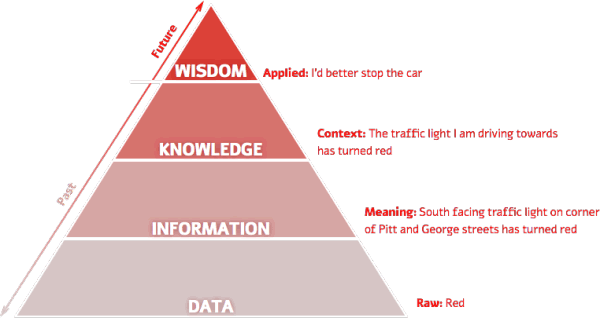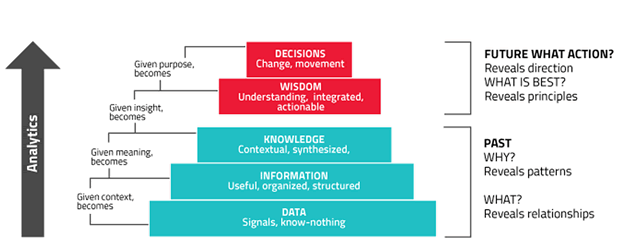The DIKW model or DIKW pyramid is an often used method, with roots in knowledge management, to explain the ways we move from data (the ‘D’) to information (I), knowledge (K) and wisdom (W) with a component of actions and decisions.
Essentially that’s what we do in digital transformation. And with Industry 4.0, IoT and AI/ML the decisions/actions can also be (semi-)autonomous, although everything depends on the nature and purpose of the data.

Simply put, DIKW is a model to look at various ways of extracting insights and value from all sorts of data: big data, small data, smart data, fast data, slow data, unstructured data, it doesn’t matter; we want outcomes, the ‘actionable intelligence’.
The DIKW model is often depicted as a hierarchical model in the shape of a pyramid and also known as the data-information-knowledge-wisdom hierarchy, among others.
The DIKW model: usage and limitations
As is the case with all models, DIKW has its limits. You’ll notice the DIKW model is quite linear and expresses a logical consequence of steps and stages with information being a contextualized ‘progression’ of data as it get more meaning.
Reality is different. Knowledge is much more than just a next stage of information. And solving data management and information management challenges these days looks far more complex with the proliferation of data sources and types. Nevertheless, the DIKW model is still used in many forms and shapes to look at the extraction of value and meaning of data and information. It’s a simple and thus strong metaphor.
One of the main criticisms of the model is indeed that it’s a hierarchical one and misses several crucial aspects of knowledge and the new data and information reality in this age of big data, APIs and ever more data and ways to capture them and turn them into action, sometimes bypassing the steps in DIKW (think about self-learning systems). Some professionals also say it underestimates the value of data (at the bottom of the pyramid) and raw data. The new oil, remember. Moreover, we gather data for a reason. So, there is already wisdom and decisions going on before the capture starts.
But still, the essence stays the same. Just look at what we do with data lakes and turning data through big data analytics into decisions and actions.
If you want to learn all about the DIKW model, there is an excellent paper in the Journal of Information Science, entitled ‘The wisdom hierarchy: representations of the DIKW hierarchy’ (PDF) and written by Jennifer Rowley of the Bangor Business School.
It’s an interesting paper as Jennifer revisits the DIKW hierarchy, a.k.a. ‘data-information-knowledge-wisdom hierarchy’, ‘Knowledge Hierarchy’, ‘Information Hierarchy’ and, almost done, ‘Knowledge Pyramid’. Given the many names it received you can imagine the DKIW Pyramid has always been very popular in the broader space of information management – and beyond.
Where is the wisdom we have lost in knowledge?
Where is the knowledge we have lost in information?
Beyond wisdom: enlightenment
As you can imagine, the DIKW Pyramid – as all models or ways of looking at things in a more or less structured way – has been discussed and looked upon from various angles with ample changes to the precise terms that have been used, sometimes in a specific context.
Some suggested to omit wisdom, others debated the exact definitions and the relationships between them and a few wanted to add a dimension of truth and moral sense to it, with the addition of something even higher than wisdom: “enlightenment”.
While it’s very interesting to discuss about things such as truth, right and wrong, enlightenment and so on, that’s not our purpose here. The long history of DIKW and views on it have made it easier to illustrate this article, that is for sure.
We use DIKW as one of several ways to define, illustrate and explain the various forms of data, information etc. in a business, transformation and customer/stakeholder perspective. We have nothing against enlightenment as a step beyond wisdom, usually defined as ‘evaluated understanding’ or ‘knowing why’, which we would then call truly understanding the purpose of information in a context of what people need and want, beyond the more factual knowledge. The enlightened business? Who knows. Another step that’s been added now and then – as you can see below – is ‘decisions’. And why not?
In her paper, Jennifer Rowley mapped the DKIW model to different types of information management systems.
- Data is related with transaction processing systems.
- Information with, indeed, information management systems.
- Knowledge with decision support systems.
- Wisdom with expert systems.

What matters: actions and decisions in DKIW
What we’re most interested in, is the action part. We’ve talked about ‘actionable data’ and ‘actionable information’ before and Jennifer Rowley refers in her paper to knowledge as being actionable information, based on the work of E.M Awad and H.M. Ghaziri, more specifically their 2004 book Knowledge Management.
Action. Decisions. That’s what we need. Because without action there is little sense in gathering, capturing, understanding, leveraging, storing and even talking about data, information and knowledge.
We mean action as in business and customer outcomes, creating value in an informed way. But of course in the bigger picture, action can also simply be learning or anything else.
You can see more variations of DIKW in our article ‘From data to value‘; there’s even a big data DIKW model.
Fun fact to know: although a 1989 paper from Russel L. Ackoff, entitled ‘From data to wisdom’ is often cited in the context of the DIKW hierarchy, there seems to be a more poetic aspect about it too.
From the poem by T.S. Eliot, The Rock:
Where is the wisdom we have lost in knowledge?
Where is the knowledge we have lost in information?

